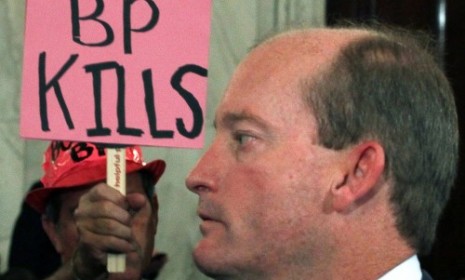The BP blame game
BP, TransOcean, and Halliburton are blaming one another for the Gulf oil spill. Here's a look at the competing accusations

Top executives of BP and two of its partners in the exploded Deepwater Horizon oil rig pointed fingers at one another before a Senate panel this week, in the first of several hearings before Congress. (Watch a CBS report about the CEOs passing the blame.) Here's a brief look at the accusations, and who's making them, as BP, TransOcean, and Halliburton publicly juggle liability for the deadly and environmentally disastrous oil spill in the Gulf of Mexico:
BP AMERICA Lamar McKay, chairman
Responsible for: Overall project operation; BP owned the oil well
The Week
Escape your echo chamber. Get the facts behind the news, plus analysis from multiple perspectives.

Sign up for The Week's Free Newsletters
From our morning news briefing to a weekly Good News Newsletter, get the best of The Week delivered directly to your inbox.
From our morning news briefing to a weekly Good News Newsletter, get the best of The Week delivered directly to your inbox.
The charge: BP's partners say it cut corners on safety. According to two rig workers and the other two companies, BP ordered gas-blocking heavy drilling fluid (or "mud") removed from the well before a cement plug was in place, an apparent diversion from normal protocol. An escaped methane gas bubble is believed to have caused the explosion.
The response: McKay blamed TransOcean for installing an apparently defective blowout preventer. That 450-ton valve is supposed to cap the well in such emergency situations.
TRANSOCEAN Steven Newman, CEO
Responsible for: Crucial well safety equipment; TransOcean owned Deepwater Horizon drilling rig
A free daily email with the biggest news stories of the day – and the best features from TheWeek.com
The charge: As "owner and operator" of the rig, TransOcean had "responsibility for the safety of drilling operations," McKay testified. The company's malfunctioning blowout preventer "was to be the fail-safe in case of an accident," he said.
The response: TransOcean said the blowout preventer tested just fine a week before the explosion. Newman said ultimate responsibility for anything that happens on the rig belongs to BP, but he also blamed Halliburton for the "sudden, catastrophic failure of the cement, the casing, or both," that was supposed to have sealed the well.
HALLIBURTON Tim Probert, president for global business
Responsible for: Sealing the well with cement
The charge: Halliburton workers didn't properly and completely plug the well, accusers say. If they had, the gas wouldn't have escaped and caused the explosion.
The response: Pobert blamed BP, TransOcean, and also federal regulators. Halliburton simply followed BP's instructions and federal regulations, he said, and if the blowout preventer had "functioned as expected, this catastrophe may well not have occurred."
Sources: CNN, Yahoo News, LA Times, Salon, Bloomberg
-
 Who is paying for Europe’s €90bn EU loan?
Who is paying for Europe’s €90bn EU loan?Today’s Big Question Kyiv secures crucial funding but the EU ‘blinked’ at the chance to strike a bold blow against Russia
-
 Quiz of The Week: 13 – 19 December
Quiz of The Week: 13 – 19 DecemberQuiz Have you been paying attention to The Week’s news?
-
 What’s causing the non-fiction slump?
What’s causing the non-fiction slump?In the Spotlight Readers are turning to crime fiction, romantasy and self help books as a form of escapism